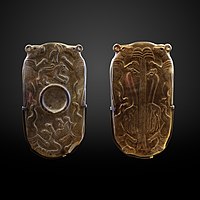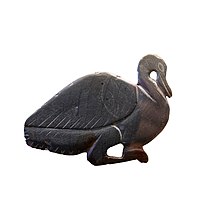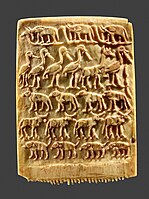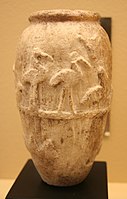Territories/
dates
[1][2][3][4] |
Egypt |
Canaan |
Ebla |
Mari |
Akshak/
Akkad |
Kish |
Uruk |
Adab |
Umma
|
Lagash |
Ur |
Elam
|
|
|
Preceded by: Chronology of the Neolithic period
|
| 4000–3200 BCE
|
Naqada culture (4000–3100 BCE)
|
Proto-Cannaanites
|
Sumerian period (4000–2340 BCE)
|
Susa I
|
| Pre-Dynastic period (4000–2900 BCE)
|
Naqada I
Naqada II

|
Egypt-Mesopotamia relations
|
Uruk period
(4000-3100 BCE)

(Anonymous "King-priests")
Legendary ante-deluvian rulers:
In Eridu: Alulim, Alalngar, then in Bad-tibira: En-men-lu-ana, En-men-gal-ana, Dumuzid, the Shepherd, then in Larag: En-sipad-zid-ana, then in Zimbir: En-men-dur-ana, then in Shuruppag: Ubara-Tutu
"then the flood swept over"[5]
|
Susa II

(Uruk influence or control)
|
| 3200–3100 BCE
|
Proto-Dynastic period
(Naqada III)
Early or legendary kings:
|
Upper Egypt
Finger Snail Fish Pen-Abu Animal Stork Canide Bull Scorpion I Shendjw Iry-Hor Ka Scorpion II Narmer / Menes
|
Lower Egypt
Hedju Hor Ny-Hor Hsekiu Khayu Tiu Thesh Neheb Wazner Nat-Hor Mekh Double Falcon Wash
|
| 3100–2900 BCE
|
Early Dynastic Period
First Dynasty of Egypt
Narmer Menes Hor-Aha Djer Djet Merneith♀ DenAnedjib Semerkhet Qa'a Sneferka Horus Bird
|
Canaanites
|
Jemdet Nasr period
|
Proto-Elamite
period
(Susa III)
(3100-2700 BCE)
|
| Great Flood
|
| 2900 BCE
|
Second Dynasty of Egypt
Hotepsekhemwy Nebra/Raneb Nynetjer Ba Nubnefer Horus Sa Weneg-Nebty Wadjenes Senedj Seth-Peribsen Sekhemib-Perenmaat Neferkara I Neferkasokar Hudjefa I Khasekhemwy

|
Early Dynastic Period I (2900–2700 BCE)
|
First Eblaite
Kingdom
(Semitic)
|
First kingdom
of Mari
(Semitic)
|
Kish I dynasty
Jushur, Kullassina-bel
Nangishlishma,
En-tarah-ana
Babum, Puannum, Kalibum
|
| 2800 BCE
|
Kalumum Zuqaqip Atab
Mashda Arwium Etana
Balih En-me-nuna
Melem-Kish Barsal-nuna
|
Uruk I dynasty
Mesh-ki-ang-gasher
|
| Enmerkar ("conqueror of Aratta")
|
| 2700 BCE
|
Early Dynastic Period II (2700–2600 BCE)
|
|
|
|
Zamug, Tizqar, Ilku
Iltasadum
|
Lugalbanda
Dumuzid, the Fisherman
|
| En-me-barage-si ("made the land of Elam submit")[6]
|
Aga of Kish 
|
Gilgamesh 
|
Old Elamite period
(2700–1500 BCE)
Indus-Mesopotamia relations
|
| 2600 BCE
|
Third Dynasty of Egypt
Djoser Sekhemkhet Sanakht Nebka Khaba Qahedjet Huni

|
Early Dynastic Period III (2600–2340 BCE)
|
Sagisu
Abur-lim
Agur-lim
Ibbi-Damu
Baba-Damu
|
|
Kish II dynasty
(5 kings)
Uhub
Mesilim
|
Ur-Nungal
Udulkalama
Labashum
|
Lagash
En-hegal
Lugalshaengur
|
Ur
A-Imdugud
Ur-Pabilsag 
Meskalamdug
(Queen Puabi)
Akalamdug
|
Enun-dara-anna
Mes-he
Melamanna
Lugal-kitun
|
Adab
Nin-kisalsi
Me-durba
Lugal-dalu
|
|
| 2575 BCE
|
Old Kingdom of Egypt
Fourth Dynasty of Egypt
Snefru Khufu

Djedefre Khafre Bikheris Menkaure Shepseskaf Thamphthis
|
Ur I dynasty
Mesannepada
"King of Ur and Kish", victorious over Uruk
|
| 2500 BCE
|
Phoenicia (2500-539 BCE)
|
Second kingdom
of Mari
(Semitic)
Ikun-Shamash
Iku-Shamagan

Ansud
Sa'umu
Ishtup-Ishar
Ikun-Mari
Iblul-Il
Nizi
|
Akshak dynasty
Unzi
Undalulu
|
Kish III dynasty
Ku-Baba
|
Uruk II dynasty
Enshakushanna
|
Mug-si
|
Umma I dynasty
Pabilgagaltuku
|
Lagash I dynasty
Ur-Nanshe

Akurgal
|
A'annepada
Meskiagnun
Elulu
Balulu
|
Awan dynasty
Peli
Tata
Ukkutahesh
Hishur
|
| 2450 BCE
|
Fifth Dynasty of Egypt
Userkaf Sahure Neferirkare Kakai Neferefre Shepseskare Nyuserre Ini Menkauhor Kaiu Djedkare Isesi Unas
|
Enar-Damu
Ishar-Malik
|
Ush
Enakalle
|
Elamite invasions
(3 kings)[7]
|
Shushuntarana
Napilhush
|
| 2425 BCE
|
Kun-Damu
|
Eannatum 
(King of Lagash, Sumer, Akkad, conqueror of Elam)
|
| 2400 BCE
|
Adub-Damu
Igrish-Halam
Irkab-Damu
|
Urur
|
Kish IV dynasty
Puzur-Suen
Ur-Zababa
|
Lugal-kinishe-dudu
Lugal-kisalsi
|
E-iginimpa'e
Meskigal
|
Ur-Lumma
Il
Gishakidu
(Queen Bara-irnun)
|
Enannatum
Entemena
Enannatum II
Enentarzi
|
Ur II dynasty
Nanni
Mesh-ki-ang-Nanna II
|
Kiku-siwe-tempti
|
| 2380 BCE
|
Sixth Dynasty of Egypt
Teti Userkare Pepi I Merenre Nemtyemsaf I Pepi II Merenre Nemtyemsaf II Netjerkare Siptah

|
Adab dynasty
Lugalannemundu
"King of the four quarters of the world"
|
| 2370 BCE
|
Isar-Damu
|
Enna-Dagan
Ikun-Ishar
Ishqi-Mari
|
Invasion of Mari
Anbu, Anba, Bazi, Zizi of Mari, Limer, Sharrum-iter[7]
|
Ukush
|
Lugalanda
Urukagina
|
Luh-ishan
|
| 2350 BCE
|
Puzur-Nirah
Ishu-Il
Shu-Sin
|
Uruk III dynasty
Lugalzagesi
(Governor of Umma, King of all Sumer)
|
| 2340 BCE
|
|
Akkadian Period (2340–2150 BCE)
|
Akkadian Empire
(Semitic)
Sargon of Akkad Rimush Manishtushu
|
Akkadian Governors:
Eshpum
Ilshu-rabi
Epirmupi
Ili-ishmani
|
| 2250 BCE
|
Naram-Sin 
|
Lugal-ushumgal
(vassal of the Akkadians)
|
| 2200 BCE
|
First Intermediate Period
Seventh Dynasty of Egypt
Eighth Dynasty of Egypt
|
Second Eblaite
Kingdom
(Semitic)
(Vassals of UR III)
|
Shakkanakku
dynasty
(Semitic)
Ididish
Shu-Dagan
Ishma-Dagan
(Vassals of the Akkadians)
|
Shar-Kali-Sharri
|
Igigi, Imi, Nanum, Ilulu (3 years)
Dudu
Shu-turul
|
Uruk IV dynasty
Ur-nigin
Ur-gigir
|
|
Lagash II dynasty
Puzer-Mama
Ur-Ningirsu I
Pirig-me
Lu-Baba
Lu-gula
Ka-ku
|
Hishep-Ratep
Helu
Khita
Puzur-Inshushinak
|
| 2150 BCE
|
Ninth Dynasty of Egypt
Meryibre Khety Neferkare VII Nebkaure Khety Setut
|
Neo-Sumerian Period (2150–2000 BCE)
|
Nûr-Mêr
Ishtup-Ilum

Ishgum-Addu
Apil-kin
|
Gutian dynasty
(21 kings)
La-erabum
Si'um
|
Kuda (Uruk)
Puzur-ili
Ur-Utu
|
|
Umma II dynasty
Lugalannatum
(vassal of the Gutians)
|
Ur-Baba
Gudea
Ur-Ningirsu
Ur-gar
Nam-mahani
|
Tirigan
|
| 2125 BCE
|
Tenth Dynasty of Egypt
Meryhathor Neferkare VIII Wahkare Khety Merykare
|
Iddi-ilum
Ili-Ishar
Tura-Dagan
Puzur-Ishtar
Hitial-Erra
Hanun-Dagan
(Vassals of Ur III)[8]
|
Uruk V dynasty
Utu-hengal
|
| 2100 BCE
|
Ur III dynasty
"Kings of Ur, Sumer and Akkad" 
Ur-Nammu Shulgi Amar-Sin Shu-Sin Ibbi-Sin
|
| 2050 BCE
|
| 2000 BCE
|
Middle Kingdom of Egypt
Eleventh Dynasty of Egypt
Mentuhotep I Intef I Intef II Intef III Mentuhotep II Mentuhotep III Mentuhotep IV
|
| circa 2000 BCE
|
Amorite invasions
|
Elamite invasions
Kindattu (Shimashki Dynasty)
|
| 2025-1763 BCE
|
Twelfth Dynasty of Egypt
Amenemhat I Senusret I Amenemhat II Senusret II Senusret III Amenemhat III Amenemhat IV Sobekneferu♀
|
Third Eblaite
Kingdom
(Semitic)
Ibbit-Lim Immeya Indilimma
|
Old Assyrian Empire
(2025–1378 BCE)
Puzur-Ashur I Shalim-ahum Ilu-shuma Erishum I Ikunum Sargon I Puzur-Ashur II Naram-Sin Erishum II Shamshi-Adad I Ishme-Dagan I Mut-Ashkur Rimush Asinum Ashur-dugul Ashur-apla-idi Nasir-Sin Sin-namir Ipqi-Ishtar Adad-salulu Adasi Bel-bani Libaya Sharma-Adad I Iptar-Sin Bazaya Lullaya Shu-Ninua Sharma-Adad II Erishum III Shamshi-Adad II Ishme-Dagan II Shamshi-Adad III Ashur-nirari I Puzur-Ashur III Enlil-nasir I Nur-ili Ashur-shaduni Ashur-rabi I Ashur-nadin-ahhe I Enlil-Nasir II Ashur-nirari II Ashur-bel-nisheshu Ashur-rim-nisheshu Ashur-nadin-ahhe II
|
Isin-Larsa period (Amorites)
Dynasty of Isin: Ishbi-Erra Shu-Ilishu Iddin-Dagan Ishme-Dagan Lipit-Eshtar Ur-Ninurta Bur-Suen Lipit-Enlil Erra-imitti Enlil-bani Zambiya Iter-pisha Ur-du-kuga Suen-magir Damiq-ilishu
Dynasty of Larsa: Naplanum Emisum Samium Zabaia Gungunum Abisare Sumuel Nur-Adad Sin-Iddinam Sin-Eribam Sin-Iqisham Silli-Adad Warad-Sin Rim-Sin I (...) Rim-Sin II
Uruk VI dynasty: Alila-hadum Sumu-binasa Naram-Sin of Uruk Sîn-kāšid Sîn-iribam Sîn-gāmil Ilum-gamil Anam of Uruk Irdanene Rim-Anum Nabi-ilišu
|
Sukkalmah dynasty
Siwe-Palar-Khuppak
|
| 1894–1595 BCE
|
Second Intermediate Period
Thirteenth Dynasty of Egypt
Fourteenth Dynasty of Egypt
|
Abraham
(Biblical)
|
Yamhad
|
First Babylonian dynasty
("Old Babylonian Period")
(Amorites)
Sumu-abum Sumu-la-El Sin-muballitSabium Apil-Sin Sin-muballit Hammurabi Samsu-iluna Abi-eshuh Ammi-ditana Ammi-saduqa Samsu-Ditana
Early Kassite rulers
|
Second Babylonian dynasty
("Sealand Dynasty")
Ilum-ma-ili Itti-ili-nibi Damqi-ilishu
Ishkibal Shushushi Gulkishar
mDIŠ+U-EN Peshgaldaramesh Ayadaragalama
Akurduana Melamkurkurra Ea-gamil
|
|
Sixteenth
Dynasty
Abydos
Dynasty
Seventeenth
Dynasty
|
Fifteenth Dynasty of Egypt
("Hyksos")
Semqen 'Aper-'Anati Sakir-Har Khyan Apepi Khamudi
|
Mitanni
(1600–1260 BCE)
Kirta Shuttarna I Parshatatar
|
| 1531–1155 BCE
|
New Kingdom of Egypt
Eighteenth Dynasty of Egypt
Ahmose I Amenhotep I
|
Third Babylonian dynasty (Kassites)
Agum-Kakrime Burnaburiash I Kashtiliash III Ulamburiash Agum III Karaindash Kadashman-harbe I Kurigalzu I Kadashman-Enlil I Burnaburiash II Kara-hardash Nazi-Bugash Kurigalzu II Nazi-Maruttash Kadashman-Turgu Kadashman-Enlil II Kudur-Enlil Shagarakti-Shuriash Kashtiliashu IV Enlil-nadin-shumi Kadashman-Harbe II Adad-shuma-iddina Adad-shuma-usur Meli-Shipak II Marduk-apla-iddina I Zababa-shuma-iddin Enlil-nadin-ahi
|
Middle Elamite period
(1500–1100 BCE)
Kidinuid dynasty
Igehalkid dynasty
Untash-Napirisha
|
| Thutmose I Thutmose II Thutmose III
|
| Hatshepsut♀ Amenhotep II Thutmose IV Amenhotep III Akhenaten Smenkhkare Neferneferuaten♀ Tutankhamun Ay Horemheb
|
Hittite Empire
|
Nineteenth Dynasty of Egypt
Ramesses I Seti I Ramesses II Merneptah Amenmesses Seti II Siptah Twosret♀
|
Elamite Empire
Shutrukid dynasty
Shutruk-Nakhunte
|
| 1155–1025 BCE
|
Twentieth Dynasty of Egypt
Setnakhte Ramesses III Ramesses IV Ramesses V Ramesses VI Ramesses VII Ramesses VIII Ramesses IX Ramesses X Ramesses XI
Third Intermediate Period
Twenty-first Dynasty of Egypt
Smendes Amenemnisu Psusennes I Amenemope Osorkon the Elder Siamun Psusennes II
|
Phoenicia
Kingdom of Israel
Saul
Ish-bosheth
David
Solomon
|
Syro-Hittite states
|
Middle Assyrian Empire
Eriba-Adad I Ashur-uballit I Enlil-nirari Arik-den-ili Adad-nirari I Shalmaneser I Tukulti-Ninurta I Ashur-nadin-apli Ashur-nirari III Enlil-kudurri-usur Ninurta-apal-Ekur Ashur-dan I Ninurta-tukulti-Ashur Mutakkil-Nusku Ashur-resh-ishi I Tiglath-Pileser I Asharid-apal-Ekur Ashur-bel-kala Eriba-Adad II Shamshi-Adad IV Ashurnasirpal I Shalmaneser II Ashur-nirari IV Ashur-rabi II Ashur-resh-ishi II Tiglath-Pileser II Ashur-dan II
|
Fourth Babylonian dynasty ("Second Dynasty of Isin")
Marduk-kabit-ahheshu Itti-Marduk-balatu Ninurta-nadin-shumi Nebuchadnezzar I Enlil-nadin-apli Marduk-nadin-ahhe Marduk-shapik-zeri Adad-apla-iddina Marduk-ahhe-eriba Marduk-zer-X Nabu-shum-libur
|
Neo-Elamite period (1100–540 BCE)
|
| 1025–934 BCE
|
Fifth, Sixth, Seventh, Eighth Babylonian dynasties ("Period of Chaos")
Simbar-shipak Ea-mukin-zeri Kashshu-nadin-ahi Eulmash-shakin-shumi Ninurta-kudurri-usur I Shirikti-shuqamuna Mar-biti-apla-usur Nabû-mukin-apli
|
| 911–745 BCE
|
Twenty-second Dynasty of Egypt
Shoshenq I Osorkon I Shoshenq II Takelot I Osorkon II Shoshenq III Shoshenq IV Pami Shoshenq V Pedubast II Osorkon IV
Twenty-third Dynasty of Egypt
Harsiese A Takelot II Pedubast I Shoshenq VI Osorkon III Takelot III Rudamun Menkheperre Ini
Twenty-fourth Dynasty of Egypt
Tefnakht Bakenranef
|
Kingdom of Samaria
Kingdom of Judah
|
Neo-Assyrian Empire
Adad-nirari II Tukulti-Ninurta II Ashurnasirpal II Shalmaneser III Shamshi-Adad V Shammuramat (regent) Adad-nirari III Shalmaneser IV Ashur-Dan III Ashur-nirari V
|
Ninth Babylonian Dynasty
Ninurta-kudurri-usur II Mar-biti-ahhe-iddina Shamash-mudammiq Nabu-shuma-ukin I Nabu-apla-iddina Marduk-zakir-shumi I Marduk-balassu-iqbi Baba-aha-iddina (five kings) Ninurta-apla-X Marduk-bel-zeri Marduk-apla-usur Eriba-Marduk Nabu-shuma-ishkun Nabonassar Nabu-nadin-zeri Nabu-shuma-ukin II Nabu-mukin-zeri
|
Humban-Tahrid dynasty
Urtak
Teumman
Ummanigash
Tammaritu I
Indabibi
Humban-haltash III
|
| 745–609 BCE
|
Twenty-fifth Dynasty of Egypt
("Black Pharaohs")
Piye Shebitku Shabaka Taharqa Tanutamun
|
Neo-Assyrian Empire
(Sargonid dynasty)
Tiglath-Pileser† Shalmaneser† Marduk-apla-iddina II Sargon† Sennacherib† Marduk-zakir-shumi II Marduk-apla-iddina II Bel-ibni Ashur-nadin-shumi† Nergal-ushezib Mushezib-Marduk Esarhaddon† Ashurbanipal Ashur-etil-ilani Sinsharishkun Sin-shumu-lishir Ashur-uballit II
|
| Assyrian conquest of Egypt
|
|
| 626–539 BCE
|
Twenty-sixth Dynasty of Egypt
Necho I Psamtik I Necho II Psamtik II Wahibre Ahmose II Psamtik III
|
Neo-Babylonian Empire
Nabopolassar Nebuchadnezzar II Amel-Marduk Neriglissar Labashi-Marduk Nabonidus
|
Median Empire
Deioces Phraortes Madius Cyaxares Astyages
|
| 539–331 BCE
|
Twenty-seventh Dynasty of Egypt
(Achaemenid conquest of Egypt)
|
Achaemenid Empire
Cyrus Cambyses Darius I Xerxes Artaxerxes I Darius II Artaxerxes II Artaxerxes III Artaxerxes IV Darius III
|
Twenty-eighth Dynasty of Egypt
Twenty-ninth Dynasty of Egypt
Thirtieth Dynasty of Egypt
|
| Thirty-first Dynasty of Egypt
|
| 331–141 BCE
|
Ptolemaic dynasty
Ptolemy I Soter Ptolemy Keraunos Ptolemy II Philadelphus Ptolemy III Euergetes Ptolemy IV Philopator Ptolemy V Epiphanes Cleopatra I Syra (regent) Ptolemy VI Philometor Ptolemy VII Neos Philopator Cleopatra II Philometor Soter Ptolemy VIII Physcon Cleopatra III Ptolemy IX Lathyros Ptolemy X Alexander Berenice III Ptolemy XI Alexander Ptolemy XII Auletes Cleopatra VI Tryphaena Berenice IV Epiphanea Ptolemy XIII Ptolemy XIV Cleopatra VII Philopator Ptolemy XV Caesarion
|
Hellenistic Period
Argead dynasty: Alexander I Philip Alexander II Antigonus
Seleucid Empire: Seleucus I Antiochus I Antiochus II Seleucus II Seleucus III Antiochus III Seleucus IV Antiochus IV Antiochus V Demetrius I Alexander III Demetrius II Antiochus VI Dionysus Diodotus Tryphon Antiochus VII Sidetes
|
| 141–30 BCE
|
Kingdom of Judea
Simon Thassi John Hyrcanus Aristobulus I Alexander Jannaeus Salome Alexandra Hyrcanus II Aristobulus II Antigonus II Mattathias
|
Alexander II Zabinas Seleucus V Philometor Antiochus VIII Grypus Antiochus IX Cyzicenus Seleucus VI Epiphanes Antiochus X Eusebes Antiochus XI Epiphanes Demetrius III Eucaerus Philip I Philadelphus Antiochus XII Dionysus Antiochus XIII Asiaticus Philip II Philoromaeus
|
Parthian Empire
Mithridates I Phraates Hyspaosines Artabanus Mithridates II Gotarzes Mithridates III Orodes I Sinatruces Phraates III Mithridates IV Orodes II Phraates IV Tiridates II Musa Phraates V Orodes III Vonones I Artabanus II Tiridates III Artabanus II Vardanes I Gotarzes II Meherdates Vonones II Vologases I Vardanes II Pacorus II Vologases II Artabanus III Osroes I
|
| 30 BCE–116 CE
|
Roman Empire
|
(Roman conquest of Egypt)
Province of Egypt
|
Judea
|
Syria
|
| 116-117 CE
|
Province of Mesopotamia under Trajan
|
Parthamaspates of Parthia
|
| 117–224 CE
|
Syria Palaestina
|
Province of Mesopotamia
|
Sinatruces II Mithridates V Vologases IV Osroes II Vologases V Vologases VI Artabanus IV
|
| 224–270 CE
|
Sasanian Empire
Province of Asoristan
Ardashir I Shapur I Hormizd I Bahram I Bahram II Bahram III Narseh Hormizd II Adur Narseh Shapur II Ardashir II Shapur III Bahram IV Yazdegerd I Shapur IV Khosrow Bahram V Yazdegerd II Hormizd III Peroz I Balash Kavad I Jamasp Kavad I Khosrow I Hormizd IV Khosrow II Bahram VI Chobin Vistahm
|
| 270–273 CE
|
Palmyrene Empire
Vaballathus Zenobia Antiochus
|
| 273–395 CE
|
Roman Empire
|
| Province of Egypt
|
Syria Palaestina
|
Syria
|
Province of Mesopotamia
|
| 395–618 CE
|
Byzantine Empire
|
| Byzantine Egypt
|
Palaestina Prima, Palaestina Secunda
|
Byzantine Syria
|
Byzantine Mesopotamia
|
| 618–628 CE
|
(Sasanian conquest of Egypt)
Province of Egypt
Shahrbaraz Sahralanyozan Shahrbaraz
|
Sasanian Empire
Province of Asoristan
Khosrow II Kavad II
|
| 628–641 CE
|
Byzantine Empire
|
Ardashir III Shahrbaraz Khosrow III Boran Shapur-i Shahrvaraz Azarmidokht Farrukh Hormizd Hormizd VI Khosrow IV Boran Yazdegerd III Peroz III Narsieh
|
| Byzantine Egypt
|
Palaestina Prima, Palaestina Secunda
|
Byzantine Syria
|
Byzantine Mesopotamia
|
| 639–651 CE
|
Muslim conquest of Egypt
|
Muslim conquest of the Levant
|
Muslim conquest of Mesopotamia and Persia
|
 Rulers of Ancient Central Asia Rulers of Ancient Central Asia
|
|
|















